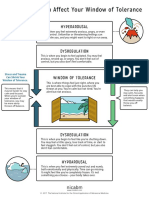NICABM RichardSchwartz Part4 Quickstart2
NICABM RichardSchwartz Part4 Quickstart2
Uploaded by
ssjeliasCopyright:
Available Formats
NICABM RichardSchwartz Part4 Quickstart2
NICABM RichardSchwartz Part4 Quickstart2
Uploaded by
ssjeliasCopyright
Available Formats
Share this document
Did you find this document useful?
Is this content inappropriate?
Copyright:
Available Formats
NICABM RichardSchwartz Part4 Quickstart2
NICABM RichardSchwartz Part4 Quickstart2
Uploaded by
ssjeliasCopyright:
Available Formats
Working with a Client’s Inner Systems to Heal Trauma Richard Schwartz, PhD - QuickStart - pg.
A QuickStart Guide: Working with a Client’s Inner Systems to Heal Trauma and
Develop Greater Calm and Compassion
by Ruth Buczynski, PhD
with Richard Schwartz, PhD
1. How to Get Interfering “Parts” of
a Client to Step Back
According to Dr. Schwartz, everyone has different
parts of themselves and, some of those parts can
become destructive following trauma. Here, Dr.
Schwartz illustrates how he helps a client shift the
roles of those inner parts to allow for more
productive dialogue.
Let’s say I have a client and I’m working with the
part that makes them binge and I get them into a
more mindful place relative to it so we’re having a
decent conversation, and suddenly, my client is
getting angry at that part.
It reminds me of situations in family sessions where
I might be talking to a teenage girl and having her
talk to her mother and I’m trying to have a better
dialogue between them but she gets angry at the
mother. You look around and the father is siding
with the daughter against the mother. You have him
move back in the room, she calms down, and things
go better.
Maybe the same thing happens in the inner system
when I’m having a client talk to one inner part, and
some other part that is polarized doesn’t like it
interfering so I ask the client, “Could you get the
Working with a Client’s Inner Systems to Heal Trauma Richard Schwartz, PhD - QuickStart - pg. 2
one who hates the binging part to step back? Now,
how do you feel toward it?”
I would find that they would shift entirely as these
other polarized parts would relax into a state that
we’d call mindfulness. In that state, clients could
have a decent dialogue with whatever the target
part was and things would start to change.
I would ask about this and say, “Who is that?” The
client would say, “That’s not really a part like these
others. That’s more of who I really am.”
We call that the Self with a capital S and this Self is
in everybody. This is a fairly quick way to access
what can become an internal leader – the one who
possesses great qualities like curiosity, calm,
confidence, compassion, and clarity. (p. 5-6 in your
transcript)
2. When the Caretaking Part Takes
Over
Dr. Schwartz describes an arthritis study he
conducted at the Brigham and Women’s Hospital.
He explains how he helped participants challenge
their internal caretaker part so they could begin to
relate differently to it.
I had 40 rheumatoid arthritis patients and a control
group of 40 and they did about nine months of this
work once a week with individual and group
Working with a Client’s Inner Systems to Heal Trauma Richard Schwartz, PhD - QuickStart - pg. 3
therapy.
This was a group of people who had never done
therapy – they were from the south end of Boston, I
think that’s the right term, Irish Catholic women, by
and large, who’d never been in therapy and we
were able to convince them to try to listen inside a
little more.
We would have them, for example, focus on their
pain. We would ask, “How do you feel?” They would
say, “Terrible – I hate it – It’s ruining my file – It
cripples my body.”
Then, we would say, “Okay, but can you get all the
parts of you that hate it to just relax a little bit? Can
you get them to step back? Can you be a little
curious about it?”
Just as in mindfulness, we were trying to help them
to separate from the pain and yet be more open to
it.
Unlike the traditional way that mindfulness might
be used, we wanted to start a dialogue with the
pain or the parts connected to the pain.
I wanted to get clients to a point where they would
say, “Well, I’m curious about it.” Then, I would say,
“Okay, ask this pain if there’s something it wants
you to know about itself.”
This was the beginning of an inner-dialogue. The
more or less standard profile of the arthritis
patients was, “Why are you giving me this pain?”
Working with a Client’s Inner Systems to Heal Trauma Richard Schwartz, PhD - QuickStart - pg. 4
The answer that came back, and this was without
them thinking, was a response like, “I hate you – I
want to cripple you.” I would ask them to stay
curious about that and ask, “Why?”
They would hear, “Because you don’t ever take care
of yourself – You take care of everybody else and
you never take care of yourself – You just exploit it
and I can’t stand it and so I’m going to make it so
you can’t keep doing that.”
Then, we’ll negotiate. We’ll go to that caretaking
part that does take care of everybody else and ask,
“Would you have to give her so much pain.”
They’ll hear, “No, but I don’t think you can actually
change that. She’s so identified with that and she
just does it automatically.” Then, we’ll ask, “Would
you let us give it a try?”
At this point, I would have patients focus on this
overactive caretaking part of them and ask, “How
do you feel toward that? Could we get you to
separate from that identification a little bit?
How do you feel toward this part that tells you to
take care of everyone else all the time?”
They’ll often say that taking care of everyone else is
“a drag sometimes.” Then, we’ll say, “Okay, can we
get the ones that want you to take care of
everybody else all the time to step back?”
Again, by getting curious about the caretaker –
having an inner-dialogue with it and asking what
Working with a Client’s Inner Systems to Heal Trauma Richard Schwartz, PhD - QuickStart - pg. 5
would happen if it didn’t take care of everybody
else, we help it unload some of the beliefs it has
about, “People will abandon me – People won’t like
me.”
We do a lot of work to help that part see that it
doesn’t have to keep doing all the caretaking, and
then we come back to the parts that are using the
pain and there’s more harmony.
Now we can negotiate a different way for them to
relate to their family that doesn’t have to involve
that pain. (pp. 9-10 in your transcript)
3. How to Introduce the Idea of
“Inner Parts” to a Client
Initially, clients may not be open to the idea of
listening to and working with inner parts. Here, Dr.
Schwartz outlines his approach in normalizing inner
parts work for his patients. He then describes how
he helps people get to know their inner parts and
begin to make changes.
As people talk about their problems, they’ll say,
“You know, I’ve got this physical symptom and I
have a lot of anxiety about it and I have a lot of
guilt, too.”
I’ll say, “One part of you feels very anxious. Is that
right?” They’ll say yes and I’ll say, “And another part
of you is criticizing you for having it and doing this
Working with a Client’s Inner Systems to Heal Trauma Richard Schwartz, PhD - QuickStart - pg. 6
to your family. Is that right?”
They’ll say yes to that, too.
We’ll continue to look at other parts in this way and
within a few minutes, I can help identify a bunch of
different parts that are related to their problem.
By this point, people don’t say, “What do you mean
parts?” By now this is the word we’ve been using.
Then, I’ll say, “Would you like to get to know some
of these parts of yourself better and maybe change
the way they operate?”
When they say yes, I’ll start the process which
involves just focusing on that part of them that feels
so afraid or anxious, and I’ll say, “See if you can find
that part in your body?”
People can readily identify where it’s located in
their body. So, I’ll say, “How do you feel toward it
right now?” They’ll often say, “I don’t like it. It
makes me so scared.”
All of that, most people can do, but when I say,
“Maybe ask a question and see what it wants you to
know.”
Some people will say, “What do you mean? What
do you mean by that?”
But again, you’d be amazed at the number of
people that just do it. I’ll say, “We don’t want to
figure out what it’s going to say. We’re just going to
wait for an answer.” You’d be amazed at how many
Working with a Client’s Inner Systems to Heal Trauma Richard Schwartz, PhD - QuickStart - pg. 7
people just say, “Okay, this is what it is saying.”
Then we’re off and running.
(p. 12)
4. How to Work with Parts That Are
Frozen in Time
When a person has experienced trauma, they can
develop extreme beliefs and emotions about what
happened to them. Often, according to Dr.
Schwartz, these beliefs take on the role of an inner
protector. Here he illustrates how he might engage
with an inner protector to identify when that role
was created, in order to find out what the client
needed at the time.
If you’re working with one of your own protectors,
say the critic, for example, I would have you
interview it and say, “What are you afraid would
happen if you didn’t do this to Ruth – if you weren’t
on her back all the time?
You might hear back, “You might be hurt.” Then I
would say, “Oh, okay, so you’re trying to protect her
from being hurt, is that right?”
The critic would say, “Yeah, that’s right.”
I would ask, “Was there a time in her life that you
really had to step in and do that? Or where in her
life did you skip this job of protecting her? Where in
the past did you get this job of showing her –
Working with a Client’s Inner Systems to Heal Trauma Richard Schwartz, PhD - QuickStart - pg. 8
protecting her from being hurt this way?”
You would start to see a scene or often a time
period and then I would say, “How old is that girl?”
She might be 10 years old. Then, I would say, “How
do you feel toward that 10 year old now that you
see her?”
She would hear, “I feel very sorry for her – that
she’s being berated by her mother…” or whenever it
is.
Then, I would say, “Okay, Ruth, I’d like you to go
into that scene and be with that child in
a way that she needed somebody.”
You would say, “Okay, I’m in there.”
I’d say, “How are you being with her?”
You’d say, “I’m holding her. I’m trying to tell the
mother to back off. I’m protecting her.”
Then, I would say, “Okay. How is she reacting?”
You’d say, “She’s really happy that I’m there.”
Then we could have you take that little girl to a safe
place and at that point, she’d be willing to unload
these emotions in the way that she’d been carrying
them.
This is a model of healing – it’s transforming the
parts of us that are frozen to past places and letting
them back into their naturally valuable states by
unloading what we call the burdens they carry – the
Working with a Client’s Inner Systems to Heal Trauma Richard Schwartz, PhD - QuickStart - pg. 9
extreme beliefs and emotions they got from the
trauma. (pp. 15-16 in you transcript)
5. Applying Inner-Parts Work to
Resolve Couples’ Conflicts
Dr. Schwartz discusses how Internal Family Systems
work can be applied when working with couples. He
describes how he works as a “referee” to encourage
couples to speak from more open-hearted,
compassionate places rather than protective parts.
Most couples come in and they’re having what we
call parts-wars. There is very little of the Self around
at least in my office and mostly there are protective
parts doing the talking – they’re blended with those
protectors.
Often I can find myself in that place with my wife –
we’re like little kids talking to each other – they feel
the shame and they feel bad that they can’t control
themselves.
So, I will stop the action when I see that and then I’ll
say, “You can do what you want outside of here, but
in my office, I’m not going to let you go up against
each other.
We’re going to create a lot of safety. I want to be
given permission from each of you that when I see
these parts of you get going, I can blow the whistle
and stop everything.
Working with a Client’s Inner Systems to Heal Trauma Richard Schwartz, PhD - QuickStart - pg. 10
I can have you both focus inside and not come back
until you can speak from a more open hearted place
about these parts. I want you to speak for your
parts rather than from your parts.”
Again, most people try to get this right away and I’m
glad they give me permission – they know what it
feels like to be out of control – in a way, they want
somebody to slow it all down and be the referee.
So, I then hold people in this place I call the Self
when they talk to each other, and when you can do
that, everything changes. I don’t even have to do
that much.
I just have them talk to each other from this place
with compassion and all the C words I was talking
about, and they start to work out their own
problems.
(pp. 20-22 in your transcript)
6. Helping Clients Begin the
Conversation with Their Pain
When a client needs to give a voice to their inner
pain, how do you help them begin the
conversation? In the example below, Dr. Lanius
describes her work in helping a client find safety
while listening to his child self.
Having the capacity to actually start engaging in a
dialogue about your pain immediately makes you
Working with a Client’s Inner Systems to Heal Trauma Richard Schwartz, PhD - QuickStart - pg. 11
feel less alone and makes you be able to use social
supports within.
One example I have was a man who had been
severely traumatized, and he had a child part of
himself that he heard inside of his head as
screaming, really calling out for an adult part of
himself. And he was very frightened of that voice.
And so an adult part of him kept saying to the child
part of him, “Shut up. You don’t deserve to speak. I
don’t want to know about what you have to say.”
And so, as you can imagine, incredible conflict
arose, and he became quite suicidal.
And so we slowly broached the topic of, “What
would it be like for you to have a conversation
between these two parts of yourself?” And initially,
he was very hesitant and very overwhelmed by this.
And I said, “Okay. Of course we’re going to go at a
pace that feels safe for you. What would you
need?”
And he said, “Well, I’d have to really separate these
two parts. I want them at the opposite corner of the
room, you know, really imagine them far apart.”
I said, “Sure. We’ll go with that.”
And then very slowly, at a pace that felt safe with
him, he began some conversation and some
empathy for these two parts, to understand where
they were coming from, so really helping him to
mentalize each part of himself.
Working with a Client’s Inner Systems to Heal Trauma Richard Schwartz, PhD - QuickStart - pg. 12
And through that, over time, these parts became
much more comfortable, and they started to move
closer to each other, whereas after about six
months, he came in and he had drawn a picture of
the adult self actually holding the child self.
And this really coincided with him having
significantly increased self-compassion. He had
significantly more positive emotion. (p. 7 in your
Talkback transcript)
7. How to Help a Client Feel
Vulnerable When They’ve “Exiled”
That Part
Often, clients’ inner vulnerability has been exiled
from a very young age – they’ve suffered painful
consequences from revealing it. And the shame
they’ve experienced as a result becomes
internalized as an inner judgmental critic. Here, Dr.
Ron Siegel describes how he applied inner parts
work in helping a client reclaim vulnerability.
One of the common protector parts is the inner
judgmental critic of which we’re all usually pretty
familiar, both in our own minds, as well as in the
minds of the people with whom we work.
And what comes to mind is a particular client of
mine who had basically a tough, male-dominated
upbringing with competitive, abusive brothers, and
Working with a Client’s Inner Systems to Heal Trauma Richard Schwartz, PhD - QuickStart - pg. 13
a pretty narcissistic dad. He grew up seeing the
world as being very much divided into winners and
losers, and he needed to be a winner in dad’s eyes,
because dad needed his sons to be a winner, but he
also couldn’t surpass his dad.
So, he was in a bit of a double blind.
And at the same time, by nature, he was a cute,
cuddly kid who kind of wanted to be close to his
mom – but his mom didn’t have a lot of power in
this system, and he was relentlessly humiliated by
his brothers.
He’d tell me about stories about being pinned down
by his older brother who would — I won’t
demonstrate it because it’s a little gross, but —
make a wad of spit, basically hanging just above him
to threaten him until he finally lets it go, pulling his
pants down to take photos and stuff.
And he could never show his vulnerability because
to show your vulnerability was like red meat to
these guys. It was just more opportunity.
So, he was deeply ashamed of his vulnerability,
deeply ashamed of his anxiety, deeply ashamed of
his desire just to be held and loved, and he actually
drank to keep these things at bay a great deal.
So, we started talking a lot about the protector part
since I knew he was very uncomfortable with his
vulnerability. We started talking a lot about, “How
did you learn that the world was divided into
winners and losers? How did you learn that it was
Working with a Client’s Inner Systems to Heal Trauma Richard Schwartz, PhD - QuickStart - pg. 14
absolutely unsafe to show that you were scared or
to show that you had longings for comfort and
closeness? Do you remember about how old you
were when you made the decision — none of that;
I’m not going to go near that?”
And once we were able to talk about that and
honor, if you will, how sensible it was for him to
exile the vulnerable part, then we could start to talk
about the vulnerable part a bit.
And he would become close to tears or start to cry,
and then he would really hate me for it. He’d say, “I
can’t believe you’re doing this to me.”
And then it would be about letting him be in charge
of the pacing really and saying, “I get it.” I may think
it’s okay and a good thing to feel this, but if you
don’t feel that way . . .
Let you be in charge of the pacing – which he did,
but he still wanted to know more and more and
allow to speak more and more the vulnerable part
and eventually did, and is now much, much more
comfortable with all these different parts of himself.
(pp. 8-9 in your Talkback transcript)
You might also like
- Internal Family Systems Therapy: Instructor's Manual100% (12)Internal Family Systems Therapy: Instructor's Manual68 pages
- Self-Therapy Workbook An Exercise Book For The IFS Process by Jay Earley100% (3)Self-Therapy Workbook An Exercise Book For The IFS Process by Jay Earley121 pages
- (Self-Therapy Series) Jay Earley - Self-Therapy, Vol. 3_ a Step-By-Step Guide to Using IFS for Eating Issues, Procrastination, The Inner Critic, Depression, Perfectionism, Anger, Communication, And Mo100% (7)(Self-Therapy Series) Jay Earley - Self-Therapy, Vol. 3_ a Step-By-Step Guide to Using IFS for Eating Issues, Procrastination, The Inner Critic, Depression, Perfectionism, Anger, Communication, And Mo241 pages
- Manual 2day Intensive Workshop Treating Complex Trauma Internal Family Systems Ifs100% (11)Manual 2day Intensive Workshop Treating Complex Trauma Internal Family Systems Ifs70 pages
- Earley, Jay - D, PH - Resolving Inner Conflict100% (2)Earley, Jay - D, PH - Resolving Inner Conflict107 pages
- Janina Fisher Healing Traumatic Wounds Brief Therapy Conf 2018 Handout Read Only100% (13)Janina Fisher Healing Traumatic Wounds Brief Therapy Conf 2018 Handout Read Only17 pages
- DARe Module 1 Manual and Educational Resources Order Form100% (6)DARe Module 1 Manual and Educational Resources Order Form19 pages
- Threat Response Sequence Infographic - Single Page100% (3)Threat Response Sequence Infographic - Single Page1 page
- Finding Self: How Internal Family Systems Has Transformed Me and My Practice100% (10)Finding Self: How Internal Family Systems Has Transformed Me and My Practice4 pages
- David Berceli Webinar Notes Trauma Releasing Exercises Notes PDF100% (2)David Berceli Webinar Notes Trauma Releasing Exercises Notes PDF23 pages
- Summary of Al Qawl Al Mufid The Explanation of Kitaab at Tawheed100% (1)Summary of Al Qawl Al Mufid The Explanation of Kitaab at Tawheed1 page
- Trust in Your Self With Internal Family SystemsNo ratings yetTrust in Your Self With Internal Family Systems13 pages
- Introduction To The Steps Questions of IFS Therapy by Lucas Forstmeyer93% (14)Introduction To The Steps Questions of IFS Therapy by Lucas Forstmeyer14 pages
- The Steps We Use To Help Protective Parts Differentiate From The Self100% (1)The Steps We Use To Help Protective Parts Differentiate From The Self1 page
- Zen and Internal Family Systems Working With Parts100% (4)Zen and Internal Family Systems Working With Parts2 pages
- Manual 2day Experiential Internal Family Systems Therapy Ifs100% (2)Manual 2day Experiential Internal Family Systems Therapy Ifs52 pages
- Moving From Accepance Toward Transformation With Ifs Therapy, Schwartz 2013100% (3)Moving From Accepance Toward Transformation With Ifs Therapy, Schwartz 201312 pages
- Exploring Your Inner Parts - An Internal Family Systems Worksheet - 060823 - Ad 1100% (3)Exploring Your Inner Parts - An Internal Family Systems Worksheet - 060823 - Ad 112 pages
- NICABM PeterLevine WhatResetsOurNervousSystemAfterTrauma100% (3)NICABM PeterLevine WhatResetsOurNervousSystemAfterTrauma7 pages
- Your True Self & Your Sub-Personalities: How To Get To Know Your Many Parts100% (1)Your True Self & Your Sub-Personalities: How To Get To Know Your Many Parts27 pages
- IFS Therapy For Children in Family Therapy, Wark2001No ratings yetIFS Therapy For Children in Family Therapy, Wark200112 pages
- NICABM InfoG How+the+Nervous+System+Responds+to+Trauma ColorNo ratings yetNICABM InfoG How+the+Nervous+System+Responds+to+Trauma Color1 page
- Summary of Jay Earley & Bonnie Weiss's Freedom from Your Inner CriticFrom EverandSummary of Jay Earley & Bonnie Weiss's Freedom from Your Inner CriticNo ratings yet
- ISTSS TraumaStressandSubstanceAbuseProb English FNLNo ratings yetISTSS TraumaStressandSubstanceAbuseProb English FNL5 pages
- When The What-Ifs' Are Overwhelming: The First Strategy IsNo ratings yetWhen The What-Ifs' Are Overwhelming: The First Strategy Is1 page
- NICABM InfoG StructuralDissociationModelNo ratings yetNICABM InfoG StructuralDissociationModel2 pages
- Li Qing Yun Four Practices Alexheyne ComNo ratings yetLi Qing Yun Four Practices Alexheyne Com10 pages
- Fundamentals of Modern Police Impact Weapons - Massad Ayoob - OcrNo ratings yetFundamentals of Modern Police Impact Weapons - Massad Ayoob - Ocr168 pages
- Cupping Therapy (Al-Hijama) - A Cure For Every Disease, Pain and Ailment (By Allah's Permission)No ratings yetCupping Therapy (Al-Hijama) - A Cure For Every Disease, Pain and Ailment (By Allah's Permission)11 pages
- Cupping Therapy (Al-Hijama) - A Cure For Every Disease, Pain and Ailment (By Allah's Permission)No ratings yetCupping Therapy (Al-Hijama) - A Cure For Every Disease, Pain and Ailment (By Allah's Permission)11 pages
- Veterinary Management System Using Rule Based SystemNo ratings yetVeterinary Management System Using Rule Based System76 pages
- Sonnykalangi,+40 +ok+ (6) +Nidia+Limarga+550-555+doiNo ratings yetSonnykalangi,+40 +ok+ (6) +Nidia+Limarga+550-555+doi6 pages
- Intentional Weight Loss Is Referred To As A: SlimmingNo ratings yetIntentional Weight Loss Is Referred To As A: Slimming5 pages
- Manuscript - 2131 - 18-TJNPR-2021-M401 Galley Proof CNo ratings yetManuscript - 2131 - 18-TJNPR-2021-M401 Galley Proof C8 pages
- Saravanan - A Transnational Feminist ViewNo ratings yetSaravanan - A Transnational Feminist View188 pages
- Nurs FPX 4010 Assessment 2 Interview and Interdisciplinary Issue IdentificationNo ratings yetNurs FPX 4010 Assessment 2 Interview and Interdisciplinary Issue Identification4 pages
- DEL Procedure For Approval of GSR 3 First Aid Training Provider - 01 April 2021No ratings yetDEL Procedure For Approval of GSR 3 First Aid Training Provider - 01 April 20212 pages
- S.6 Economics Population and Labour Economics Notes 2No ratings yetS.6 Economics Population and Labour Economics Notes 243 pages
- Abortion and Eugenics in Nazi Germany PDFNo ratings yetAbortion and Eugenics in Nazi Germany PDF33 pages
- Dental Caries Status in Autistic Children: A Meta Analysis: Yujian Zhang Ling Lin Jianbo Liu Ling Shi Jianping LuNo ratings yetDental Caries Status in Autistic Children: A Meta Analysis: Yujian Zhang Ling Lin Jianbo Liu Ling Shi Jianping Lu9 pages
- The Human Body Is A Complex Network of Cells Tissues and OrgansNo ratings yetThe Human Body Is A Complex Network of Cells Tissues and Organs1 page
- Development & Construction of A State-Of-The-Art Inter-State Bus Terminal Equipped With All Modern Amenities On A Public Private Partnership BasisNo ratings yetDevelopment & Construction of A State-Of-The-Art Inter-State Bus Terminal Equipped With All Modern Amenities On A Public Private Partnership Basis1 page
- Intrinsic and Extrinsic Motivational Factors and Type A BehaviorNo ratings yetIntrinsic and Extrinsic Motivational Factors and Type A Behavior9 pages
- The Effects of Endurance and Strength Exercise On CV ResponseNo ratings yetThe Effects of Endurance and Strength Exercise On CV Response2 pages
- Case Study 10 Financial Planning and ForecastingNo ratings yetCase Study 10 Financial Planning and Forecasting2 pages
- Top 7 Natural Homeopathic Medicines For Schizophrenia - HomeopathyNo ratings yetTop 7 Natural Homeopathic Medicines For Schizophrenia - Homeopathy118 pages
- Job Safety Analysis (JSA) - CONCRETE WORKS - Date100% (3)Job Safety Analysis (JSA) - CONCRETE WORKS - Date2 pages
- Internal Family Systems Therapy: Instructor's ManualInternal Family Systems Therapy: Instructor's Manual
- Self-Therapy Workbook An Exercise Book For The IFS Process by Jay EarleySelf-Therapy Workbook An Exercise Book For The IFS Process by Jay Earley
- (Self-Therapy Series) Jay Earley - Self-Therapy, Vol. 3_ a Step-By-Step Guide to Using IFS for Eating Issues, Procrastination, The Inner Critic, Depression, Perfectionism, Anger, Communication, And Mo(Self-Therapy Series) Jay Earley - Self-Therapy, Vol. 3_ a Step-By-Step Guide to Using IFS for Eating Issues, Procrastination, The Inner Critic, Depression, Perfectionism, Anger, Communication, And Mo
- Manual 2day Intensive Workshop Treating Complex Trauma Internal Family Systems IfsManual 2day Intensive Workshop Treating Complex Trauma Internal Family Systems Ifs
- Janina Fisher Healing Traumatic Wounds Brief Therapy Conf 2018 Handout Read OnlyJanina Fisher Healing Traumatic Wounds Brief Therapy Conf 2018 Handout Read Only
- DARe Module 1 Manual and Educational Resources Order FormDARe Module 1 Manual and Educational Resources Order Form
- Threat Response Sequence Infographic - Single PageThreat Response Sequence Infographic - Single Page
- Finding Self: How Internal Family Systems Has Transformed Me and My PracticeFinding Self: How Internal Family Systems Has Transformed Me and My Practice
- David Berceli Webinar Notes Trauma Releasing Exercises Notes PDFDavid Berceli Webinar Notes Trauma Releasing Exercises Notes PDF
- Summary of Al Qawl Al Mufid The Explanation of Kitaab at TawheedSummary of Al Qawl Al Mufid The Explanation of Kitaab at Tawheed
- Introduction To The Steps Questions of IFS Therapy by Lucas ForstmeyerIntroduction To The Steps Questions of IFS Therapy by Lucas Forstmeyer
- The Steps We Use To Help Protective Parts Differentiate From The SelfThe Steps We Use To Help Protective Parts Differentiate From The Self
- Zen and Internal Family Systems Working With PartsZen and Internal Family Systems Working With Parts
- Manual 2day Experiential Internal Family Systems Therapy IfsManual 2day Experiential Internal Family Systems Therapy Ifs
- Moving From Accepance Toward Transformation With Ifs Therapy, Schwartz 2013Moving From Accepance Toward Transformation With Ifs Therapy, Schwartz 2013
- Exploring Your Inner Parts - An Internal Family Systems Worksheet - 060823 - Ad 1Exploring Your Inner Parts - An Internal Family Systems Worksheet - 060823 - Ad 1
- NICABM PeterLevine WhatResetsOurNervousSystemAfterTraumaNICABM PeterLevine WhatResetsOurNervousSystemAfterTrauma
- Your True Self & Your Sub-Personalities: How To Get To Know Your Many PartsYour True Self & Your Sub-Personalities: How To Get To Know Your Many Parts
- IFS Therapy For Children in Family Therapy, Wark2001IFS Therapy For Children in Family Therapy, Wark2001
- NICABM InfoG How+the+Nervous+System+Responds+to+Trauma ColorNICABM InfoG How+the+Nervous+System+Responds+to+Trauma Color
- Summary of Babette Rothschild's 8 Keys to Safe Trauma RecoveryFrom EverandSummary of Babette Rothschild's 8 Keys to Safe Trauma Recovery
- Summary of Jay Earley & Bonnie Weiss's Freedom from Your Inner CriticFrom EverandSummary of Jay Earley & Bonnie Weiss's Freedom from Your Inner Critic
- Summary of Robin Shapiro's Easy Ego State InterventionsFrom EverandSummary of Robin Shapiro's Easy Ego State Interventions
- Summary of Deb Dana's Polyvagal Exercises for Safety and ConnectionFrom EverandSummary of Deb Dana's Polyvagal Exercises for Safety and Connection
- ISTSS TraumaStressandSubstanceAbuseProb English FNLISTSS TraumaStressandSubstanceAbuseProb English FNL
- When The What-Ifs' Are Overwhelming: The First Strategy IsWhen The What-Ifs' Are Overwhelming: The First Strategy Is
- Fundamentals of Modern Police Impact Weapons - Massad Ayoob - OcrFundamentals of Modern Police Impact Weapons - Massad Ayoob - Ocr
- Cupping Therapy (Al-Hijama) - A Cure For Every Disease, Pain and Ailment (By Allah's Permission)Cupping Therapy (Al-Hijama) - A Cure For Every Disease, Pain and Ailment (By Allah's Permission)
- Cupping Therapy (Al-Hijama) - A Cure For Every Disease, Pain and Ailment (By Allah's Permission)Cupping Therapy (Al-Hijama) - A Cure For Every Disease, Pain and Ailment (By Allah's Permission)
- Veterinary Management System Using Rule Based SystemVeterinary Management System Using Rule Based System
- Sonnykalangi,+40 +ok+ (6) +Nidia+Limarga+550-555+doiSonnykalangi,+40 +ok+ (6) +Nidia+Limarga+550-555+doi
- Intentional Weight Loss Is Referred To As A: SlimmingIntentional Weight Loss Is Referred To As A: Slimming
- Manuscript - 2131 - 18-TJNPR-2021-M401 Galley Proof CManuscript - 2131 - 18-TJNPR-2021-M401 Galley Proof C
- Nurs FPX 4010 Assessment 2 Interview and Interdisciplinary Issue IdentificationNurs FPX 4010 Assessment 2 Interview and Interdisciplinary Issue Identification
- DEL Procedure For Approval of GSR 3 First Aid Training Provider - 01 April 2021DEL Procedure For Approval of GSR 3 First Aid Training Provider - 01 April 2021
- S.6 Economics Population and Labour Economics Notes 2S.6 Economics Population and Labour Economics Notes 2
- Dental Caries Status in Autistic Children: A Meta Analysis: Yujian Zhang Ling Lin Jianbo Liu Ling Shi Jianping LuDental Caries Status in Autistic Children: A Meta Analysis: Yujian Zhang Ling Lin Jianbo Liu Ling Shi Jianping Lu
- The Human Body Is A Complex Network of Cells Tissues and OrgansThe Human Body Is A Complex Network of Cells Tissues and Organs
- Development & Construction of A State-Of-The-Art Inter-State Bus Terminal Equipped With All Modern Amenities On A Public Private Partnership BasisDevelopment & Construction of A State-Of-The-Art Inter-State Bus Terminal Equipped With All Modern Amenities On A Public Private Partnership Basis
- Intrinsic and Extrinsic Motivational Factors and Type A BehaviorIntrinsic and Extrinsic Motivational Factors and Type A Behavior
- The Effects of Endurance and Strength Exercise On CV ResponseThe Effects of Endurance and Strength Exercise On CV Response
- Top 7 Natural Homeopathic Medicines For Schizophrenia - HomeopathyTop 7 Natural Homeopathic Medicines For Schizophrenia - Homeopathy





































































































